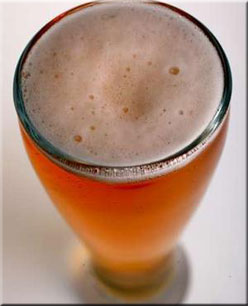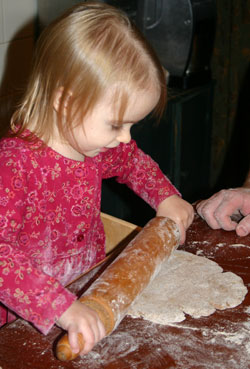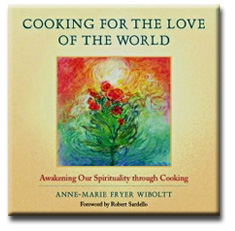
Many people of traditional cultures naturally understood which foods were healthy and nutritious. Modern people, however, have to consult charts and nutritional tables to learn if a food is healthful. (Detailed research and charts are readily available on line.) Grains are an example of a food that is well represented in all the vital nutrient groups: vitamins, minerals, proteins, carbohydrates, oils and fibers. These nutrients come in a very balanced proportion to each other. This balanced nutritional content is one reason why people, who have adjusted to a diet including grains, seldom feel cravings for something missing. With a few added condiments such as healthy oils and fats, and fermented foods much of human nutritional needs are supplied by these lovely grains. Below is a highlight of a few of the essential nutrients in grains.
The vitamins in grains are many. Dependent on growing methods and geography, grains contain several essential B vitamins; B1, B2, and B6. Vitamin E is also found in all grains as well as vitamin K1.
The mineral and trace elements in grains support the digestion and assimilation of the other nutrients in the grain. Grains are a good source of organic silica as well(especially abundant in millet). Many of these minerals and trace elements assist in especially healthy brain function, nervous system, and in the building process of healthy bones, muscles, skin, hair, and nails. Thus grains are a natural beauty aids.
The oils supplied by grains are unsaturated and contain many "essential " oils that are necessary for the body. Linolic fatty acids are some of them, which among other benefits, prevents cholesterol build up, and break up fats.
Proteins are also present in grains. As the matter of facts, grains are an excellent source of protein, containing 1/2- 2/3 as much as that which is provided in the same amount of meat and fowl. In a meat centered diet however, when a high proportion of the body's caloric intake is supplied simply by proteins, an acidic condition can be created in the blood. When this happens, the body drains its own mineral supply in an attempt to neutralize these acids.
The carbohydrates provided by grains are what scientists call polysaccharides. These are complex chains of sugar molecules and easily digested when chewed well, releasing a steady stream of carbohydrates that provides a stable energy flow. Quick burning carbohydrates on the other hand, such as sugar, and other sweets, enter the bloodstream in a rush and puts strain on the liver, pancreas, heart, and other organs. They also produce highs and lows that become mood swings.
The bran is an important part of the grains as well. It is a shame that when making rice "white", or turning wheat into white flour, this valuable substance is removed. Most of grains' vitamins and minerals are stored in and under the protective coating of bran, and so are lost with its removal. Much of the protein in wheat is also taken away, because this is attracted to the bran and germ. Additionally, bran contains enzymes, that aid in the digestion of the grain, and absorbs excess bile. It also acts as a roughage that keeps the intestines regular and functioning well.
Whole grains can maintain their nutritive components over a long period of time. Once the bran has been removed, as with white rice or white flour, it looses most of its nutrients. In its whole state, grains are naturally sealed so perfectly, that grains are still capable of sprouting into new life years after their harvest. Whole grain not only provides us with an excellent form of nourishment, but also with the potential of life creating forces.
GOMAKU RICE
3 c short grain brown rice
1 table spoon lemon juice
Kernels from 1 corn on the cob
1 6" piece kombu sea vegetables
1/2 lb tempeh, or chicken
4 c water
1/4 tsp sea salt
1 carrot, diced
Butter, olive or coconut oil
2 onions, diced
Wash the rice and place it in a pot with the water and lemon juice. Let it soak for 6-8 hours.
Bring the rice to a boil. Soak the kombu for 2 min, and cut it in cubes. Cube the tempeh or chicken and fry the cubes in butter or oil until golden. When the rice has come to a boil add the kombu, carrots, corn, onions, tempeh and salt. Cover with a lid and let it simmer for 60 min. Let the rice sit for 5 min before placing it in a serving bowl. Garnished with finely cut parsley, gomaku rice is a little colorful meal by itself and can be served as it is with a few pieces of pickles.
*Variation: Use rice and other grains together, beans, or beef instead of tempeh. Use different vegetables, mushrooms etc. The rice can be pressure cooked for 40 min, instead of being boiled.

Anne-Marie Fryer Wiboltt is a Waldorf class and kindergarten teacher, biodynamic farmer, author and nutritional counselor. She has taught nutritional cooking and counseled for 25 years in her homeland Denmark, Europe and the United States.
She trained as a macrobiotic cooking teacher and counselor and studied the principles of oriental medicine and the research of Dr. Weston A. Price before embracing the anthroposophical approach to nutrition, food and cooking.
This Four week course will explore some of the many benefits of fermented and cultured foods,

and why it is important to include them regularly with every meal. You will be guided through the steps of making sauerkraut, kimchi, pickled vegetables, kefir, soft cheese, and yogurt, as well as get a chance to discover new fermented drinks such as kvass, wines, and beers. I will aim at answering personal questions around your culturing and fermenting experiences.
Intuitively we know that cultured and fermented foods are real health foods. Naturally fermented and cultured foods are an exceptional way to prepare different ingredients and some of the most important side dishes and condiments in our diet. They are often overlooked or not mentioned when we describe what we had for dinner, and yet they are pivotal in creating a well-balanced, nutritious meal.
They add a bounty of nourishing, life-promoting substances and life forces, almost miraculous curative properties, and a wealth of colors, flavors, and shapes. They increase the appetite, stimulate the digestion, and make any simple meal festive and satisfying. The course will be highly practical with many hands-on activities.

In this Four week course you will learn about the nutritional needs of your growing child and receive delicious, seasonal, wholesome nutritious menus and recipes on affordable budget so as to encourage children to eat and live healthy.
During this course we will explore the nutritious needs for your growing child.
We will discover how rhythm, simplicity and nourishing activities support a healthy child development. You will find new ways to encourage your child to develop a taste for natural, wholesome foods as well as receive and create delicious, seasonal nutritious menus and recipes that stay within the limits of your budget.
Cooking for the Love of the World:
Awakening our Spirituality through Cooking
by Anne-Marie Fryer Wiboltt

A heart-centered, warmth-filled guide to the nurturing art of cooking. 200 pages, softbound


 Anne-Marie Fryer Wiboltt is a Waldorf class and kindergarten teacher, biodynamic farmer, author and nutritional counselor. She has taught nutritional cooking and counseled for 25 years in her homeland Denmark, Europe and the United States.
Anne-Marie Fryer Wiboltt is a Waldorf class and kindergarten teacher, biodynamic farmer, author and nutritional counselor. She has taught nutritional cooking and counseled for 25 years in her homeland Denmark, Europe and the United States. and why it is important to include them regularly with every meal. You will be guided through the steps of making sauerkraut, kimchi, pickled vegetables, kefir, soft cheese, and yogurt, as well as get a chance to discover new fermented drinks such as kvass, wines, and beers. I will aim at answering personal questions around your culturing and fermenting experiences.
and why it is important to include them regularly with every meal. You will be guided through the steps of making sauerkraut, kimchi, pickled vegetables, kefir, soft cheese, and yogurt, as well as get a chance to discover new fermented drinks such as kvass, wines, and beers. I will aim at answering personal questions around your culturing and fermenting experiences. In this Four week course you will learn about the nutritional needs of your growing child and receive delicious, seasonal, wholesome nutritious menus and recipes on affordable budget so as to encourage children to eat and live healthy.
In this Four week course you will learn about the nutritional needs of your growing child and receive delicious, seasonal, wholesome nutritious menus and recipes on affordable budget so as to encourage children to eat and live healthy.

